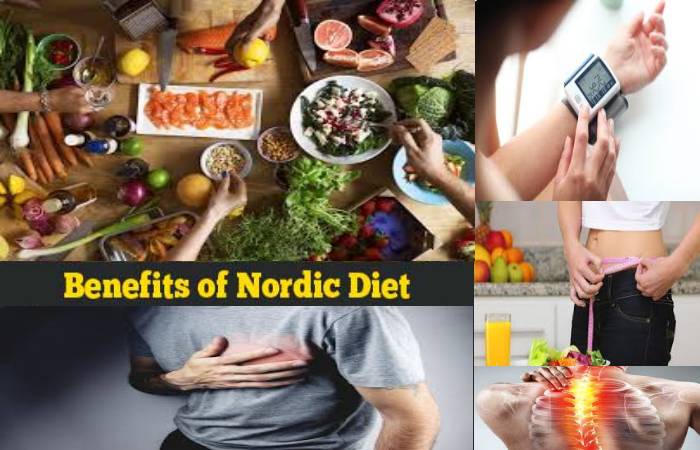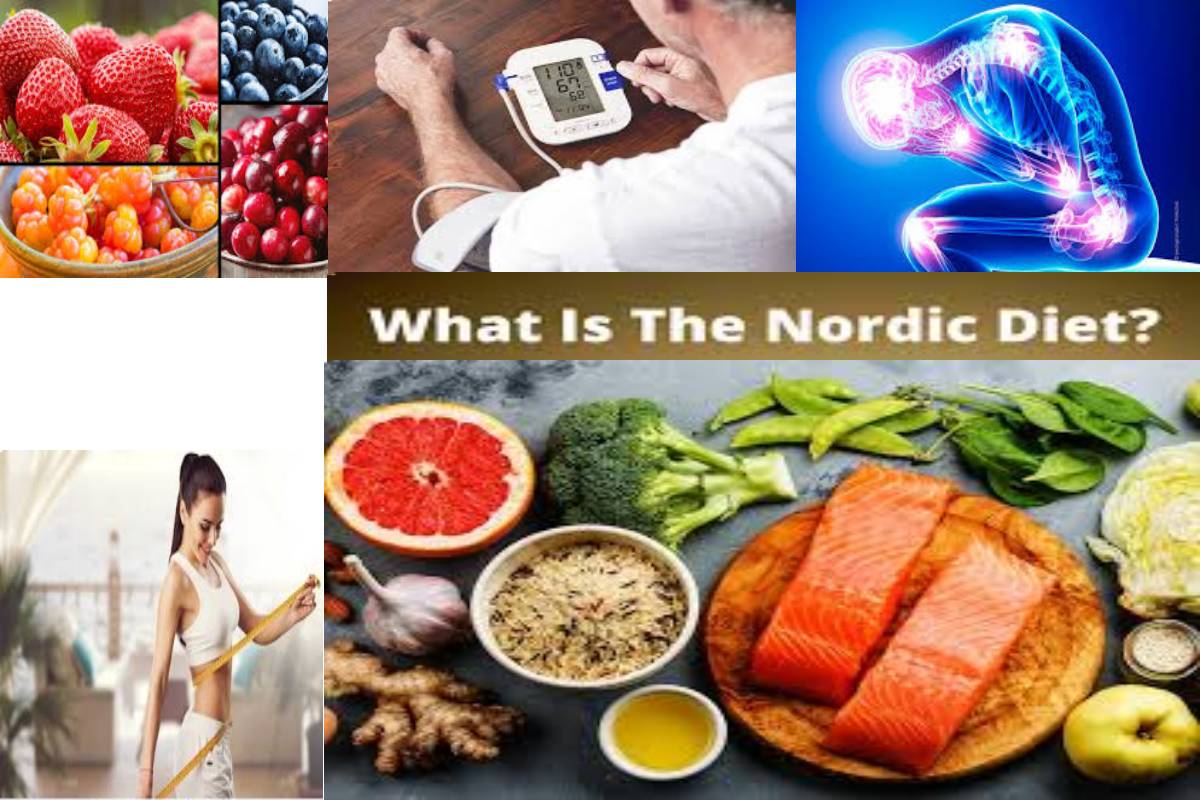Table of Contents
What is the Nordic Diet?
Nordic diet is an eating method that focuses on traditional foods from the countries (Norway, Denmark, Sweden, Finland, and Iceland).
The Nordic Diet create in 2004 by a group of nutritionists, scientists, and chefs, to address the rising rates of obesity and unsustainable agricultural practices in the Nordic countries.
Compared to an average Western diet, it contains less sugar, less fat, twice the fiber, and twice the amount of fish and shellfish.
What are the Benefits of the Nordic Diet?

Healthy eating goes far beyond weight loss. It can also lead to significant improvements in metabolic health and lower the risk of all kinds of chronic diseases.
1. Blood Pressure
- It reduced systolic and diastolic blood pressure by 5.1 and 3.2 mmHg, respectively, compared to a control diet.
- Its reduction in diastolic blood pressure in participants with metabolic syndrome.
2. Cholesterol and Triglycerides
- Even though the Nordic diet is high in many heart-healthy foods, its effects on cholesterol and triglycerides are inconsistent.
- A reduction in triglycerides, but HDL and LDL cholesterol’s effects appear to be so small that they are not statistically significant.
- However, a slight reduction in the HDL-C / LDL-c ratio and the Apo B / Apo A1 ratio, and non-HDL cholesterol are critical risk factors for heart disease.
3. Control Blood Sugar
- The Nordic diet does not appear to be very useful in lowering blood sugar levels, but one study found a small reduction in fasting blood glucose.
4. Inflammation
- Chronic inflammation is a significant driver of many serious diseases.
- The Nordic diet and inflammation have yielded mixed results. A reduction in the inflammatory marker CRP, while others found no statistically significant effect.
- It reduced the expression of genes related to inflammation in the body’s fat tissues.
5. Help to Weight Loss
- those who ate a Nordic diet lost 10.4 pounds (4.7 kg), while those who followed a typical diet lost only 3.3 pounds (1.5 kg).
- It is quite impressive, especially considering that people do not instruct to restrict calories.
- However, in a follow-up study one year later, the Nordic diet participants gained the most weight loss.
- These results are very typical of long-term studies on weight loss. People lose weight at first, but then gradually come back over 1-2 years.
- Weight reduction effects of the Nordic diet. In this 6-week long study, lost 4% of body weight, significantly more than those on a standard diet.
Food List of the Nordic Diet

The Nordic diet base on whole grains, fruits, vegetables, three servings of fish a week – preferably bluefish -, skim milk and avoid sugary products, food additives, and excess meat (or take it of higher quality).
Also, a difference with the Mediterranean is rapeseed or canola oil as the base for cooking instead of olive oil.
Some concrete examples so that we can begin to follow the Nordic diet at home by eating the following foods:
Salmon
Fatty and lean fish and a variety of seafood: mackerel, salmon, herring, etc.
Turnip
Root vegetables from the area: turnip, parsnips, celeriac, carrot, beet, etc.
Cabbages
Vegetables and tubers: onion, potatoes, cabbage, cabbages, etc.
Grain Cereals
Legumes and grain cereals: barley, rye, or oats.
Red Fruits
Berry like blueberries, raspberries, and red berries.
Rapeseed Oil
Rapeseed (canola) oil.
How Does the Nordic Diet Work?
- The Nordic diet puts the body into ketosis and prioritizes low-glycemic (GM) ingredients.
- Glucose is released into the blood more slowly, and the body uses stored fat for energy.
- In this way, you also avoid storing excess calories in fatty tissue.
- It is possible to lose up to four kilos in the first month, in addition to reducing swelling and cellulite with better circulation.
- Any diet that eliminates junk food, processed foods and sugars in all their forms encourages the consumption of vegetables is valid.
- Still, it stands out above others for being mostly balanced and healthy.
Which Foods to Eat and Avoid on the Nordic Diet?
The Nordic diet emphasizes locally grown and sustainable food sources, focusing on healthy foods according to “mainstream” nutritional science.
1. Eat Often
Eat healthy like fruits, berries, vegetables, legumes, potatoes, whole grains, nuts, seeds, rye bread, fish, shellfish, low-fat dairy products, herbs, spices, and rapeseed ( canola oil).
2. Eat-in Moderation
Moderation eats like, free-range eggs, cheese, and yogurt.
3. Eat Rarely
Eat rarely like red meat and animal fats.
4. Don’t Eat
Don’t eat sugar-sweetened beverages, added sugars, processed meats, food additives, and refined fast foods.
The Nordic diet is very similar to the Mediterranean diet. The most significant difference is that it emphasizes canola/rapeseed oil rather than extra virgin olive oil.
As the critics correctly point out, many foods on the “Nordic” diet never eat in the Nordic countries in their day. These include low-fat milk and canola oil, which are everyday foods. Fruit also doesn’t grow well in the north, except maybe for some berries.
Criticism of the Nordic Diet
- As critics correctly point out, some Nordic diet foods did not exist in the Nordic countries centuries ago.
- For example, low-fat dairy products or most fruits are included and do not often grow in these countries, except for apples and berries.
- However, this diet, not design to reflect the traditional it, emphasizes healthy foods that source in modern-day Scandinavia.
Environmental Aspect of the Nordic Diet
- It can be a good option from an environmental perspective. The emphasis is on food that is locally grown and sustainably grown.
- Some proponents of the diet also recommend consuming organic foods.
- The evidence behind it is not particularly impressive.
- It causes short-term weight loss and reduced blood pressure and inflammatory markers, but the results appear weak and inconsistent.
- Any diet that emphasizes real food rather than traditional western junk food is likely to lead to weight loss and health improvements.
- It has proved, time and again, in hundreds of studies on several different diets.
- However, there is nothing magical about “Nordic” food or “eating like a Viking.”
- The diet works because it replaces processed foods with whole, single-ingredient foods. That’s.
Conclusion
It appears to be useful for short-term weight loss, even when people not ask to restrict their calorie intake.
The effects on cholesterol, blood triglycerides, blood sugar levels, and inflammatory markers are weak and inconsistent.
Also Read: Fever – Definition, Symptoms, Best 10 Home Remedies, and More

